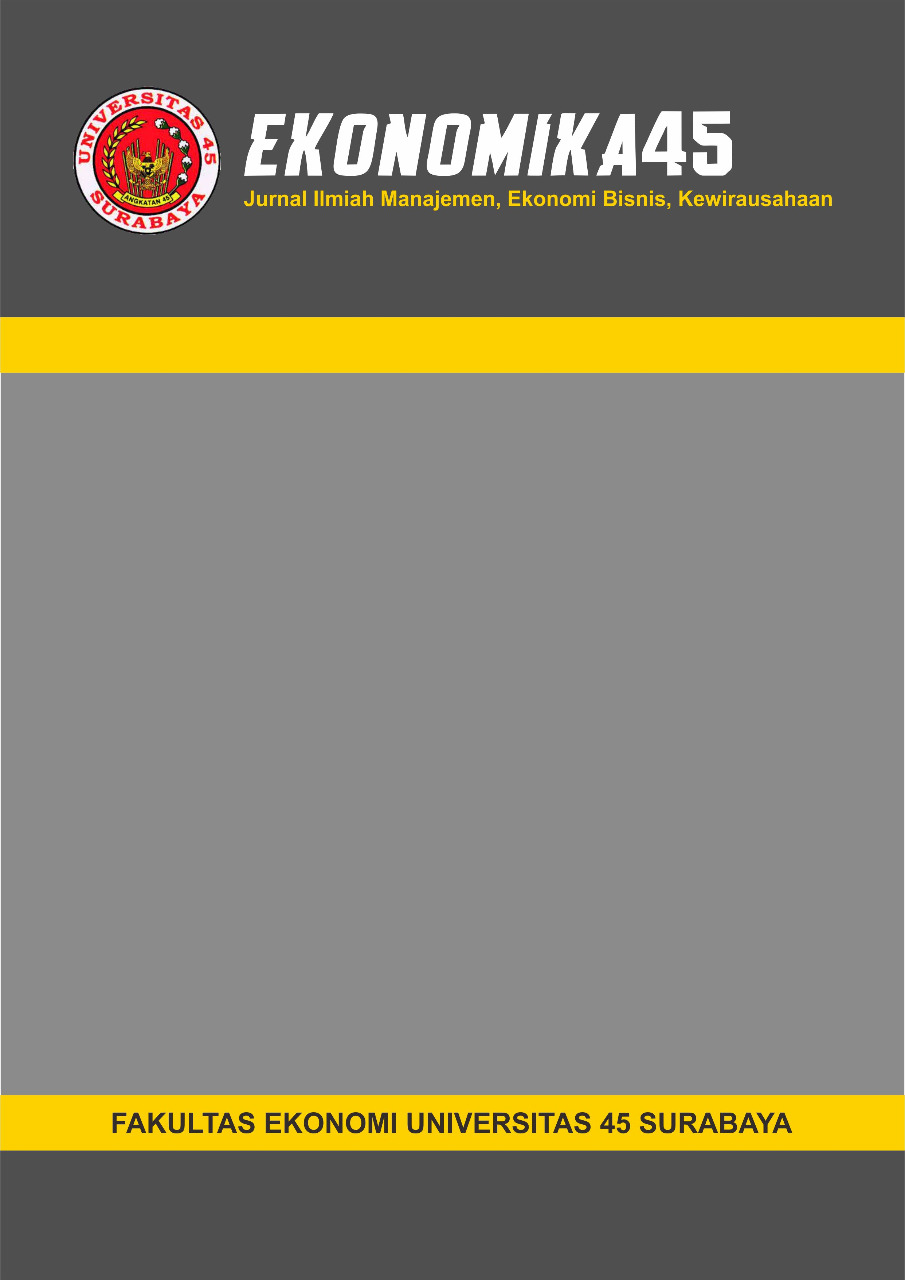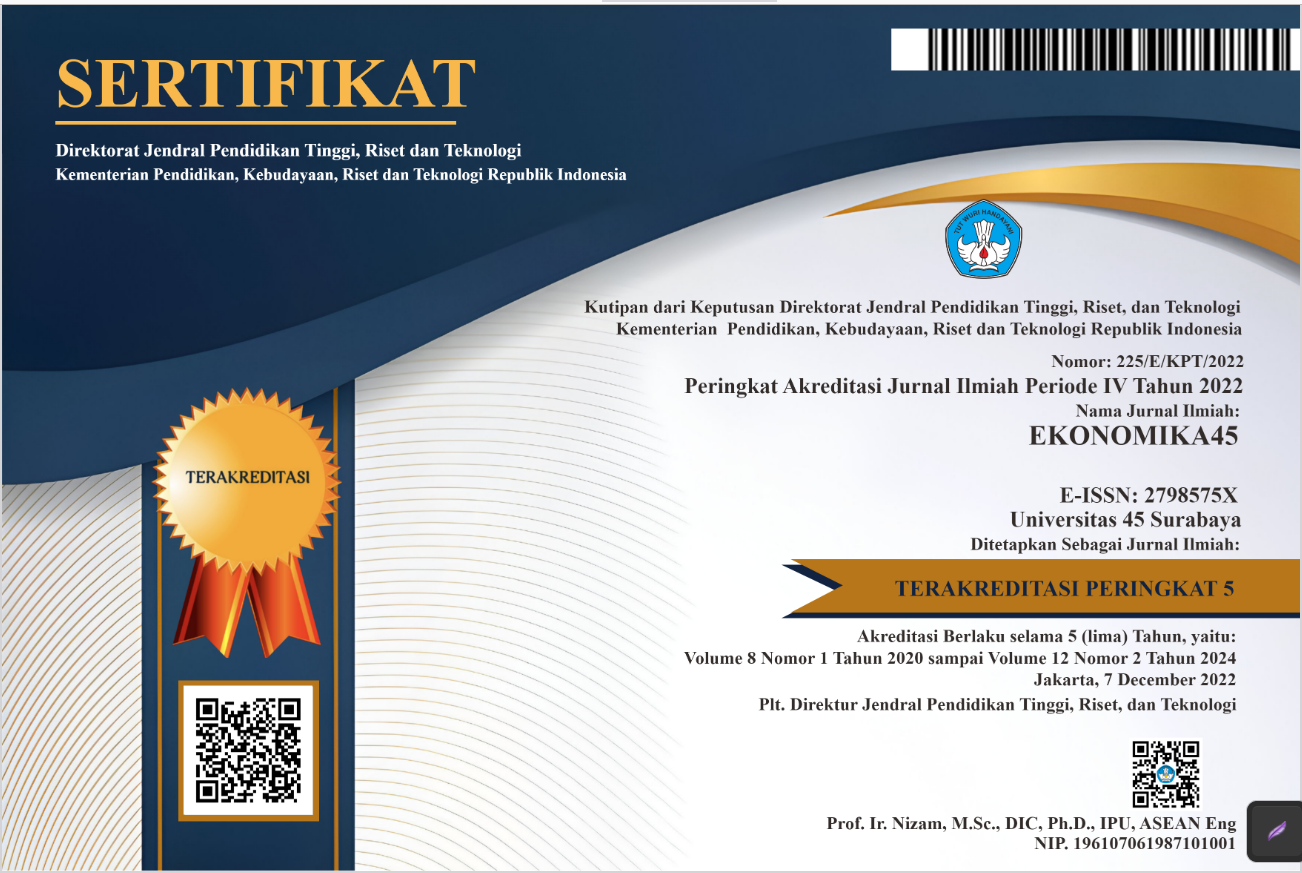Implikasi Strategis Peran Chief Happiness Officer (CHO) dalam Meningkatkan Kesejahteraan, Produktivitas dan Loyalitas Karyawan
DOI:
https://doi.org/10.30640/ekonomika45.v12i2.4677Keywords:
Chief Happiness Officer, employee well-being, productivity, loyaltyAbstract
The role of the Chief Happiness Officer (CHO) is increasingly important in human resource (HR) management strategies in the modern era. This article discusses how CHO can appropriately contribute to improving employee well-being, productivity, and loyalty based on a review of the existing literature. CHO is tasked with creating a positive work environment by designing comprehensive well-being programs, such as flexibility at work, psychological support, and the development of an organizational culture that focuses on employee happiness. The research method used is a type of putaka with research data sources from books, journals, reports, news and other things related to the title. The results of the study show that the existence of CHO can significantly reduce work stress, increase employee engagement, and reduce turnover rates. However, there are still challenges in implementing the role of CHO, especially in the non-technology sector and small and medium enterprises (SMEs). This is evidenced by companies that implement CHO roles tend to experience a decrease in turnover rates, which shows that investing in employee well-being is not only beneficial to individuals, but also to the organization as a whole. For example, Coca-Cola, TikTok, EY, Deloitte, SAP. Therefore, the results of this article recommend the need for further research to measure the effectiveness of CHO in various industrial sectors as well as develop more precise measurement standards.
References
Afianty, S., & Rosdiana, Y. (2023). Pengaruh budaya organisasi dan gaya kepemimpinan terhadap kinerja karyawan. Bandung Conference Series: Accountancy, 3(2), 742–748. https://doi.org/10.29313/bcsa.v3i2.7534
Annisa, M., Zeifuddin, A., Dyah, A. S., Hilya, S. R., & Anshori, M. I. (2023). Kesejahteraan mental karyawan dalam era digital: Dampak teknologi pada kesejahteraan mental karyawan dan upaya untuk mengatasi stres digital. Jurnal Ekonomi, Bisnis dan Manajemen, 2(4), 113–130. https://doi.org/10.58192/ebismen.v2i4.1385
Anshori, M. I., Caroline, Putro, S. E., & Ariyadi, M. Y. (2023). Peran kepemimpinan komunikasi internal dan pengembangan karir terhadap kepuasan kerja karyawan pada perusahaan telekomunikasi. Jurnal EMT KITA, 7(4), 1245–1257. https://doi.org/10.35870/emt.v7i4.1672
Ardi, A., Cahyadi, H., Meilani, Y. F. C. P., & Pramono, R. (2024). Talent attraction through flexible work anytime from anywhere. Journal of Infrastructure, Policy and Development, 8(3), 1–20. https://doi.org/10.24294/jipd.v8i3.2998
Arthur, J. B., & Aiman-Smith, L. (2001). Gainsharing and organizational learning: An analysis of employee suggestions over time. Academy of Management Journal, 44(4), 737–754. https://doi.org/10.5465/3069413
Aulia, N., & Anshori, M. I. (2022). Pengaruh motivasi kerja terhadap kinerja karyawan melalui perilaku kreatif pemimpin sebagai variabel intervening (Studi pada karyawan KSPPS BMT NU Jawa Timur di Kec. Gapura Kabupaten Sumenep). Jurnal Kajian Ilmu Manajemen (JKIM), 2(3). https://doi.org/10.21107/jkim.v2i3.17361
Bakker, A. B., & Albrecht, S. (2018). Work engagement: Current trends. Career Development International, 23(1), 4–11. https://doi.org/10.1108/CDI-11-2017-0207
Bakker, A. B., & Demerouti, E. (2014). Job demands–resources theory. In Wellbeing (pp. 1–28). Wiley. https://doi.org/10.1002/9781118539415.wbwell019
Eka Rachmawati, Hidayatullah, A. R., & Anshori, M. I. (2023). Gaya kepemimpinan adaptive leadership seorang pemimpin: Studi literatur. Jurnal of Management and Social Sciences, 1(3), 195–210. https://doi.org/10.59031/jmsc.v1i3.168
Fauziyah, S. N., Wulandari, S., P., R. A., & Anshori, M. I. (2024). Peran kepemimpinan adaptif dalam mendorong inovasi dan kreativitas tim: Studi literatur. Business and Investment Review, 2(3), 14–19. https://doi.org/10.61292/birev.105
Fisher, C. D. (2010). Happiness at work. International Journal of Management Reviews, 12(4), 384–412. https://doi.org/10.1111/j.1468-2370.2009.00270.x
Gigli, A., Francisci, S., Capodaglio, G., Pierannunzio, D., Mallone, S., Tavilla, A., Lopez, T., Zorzi, M., Stracci, F., Busco, S., ... Guzzinati, S. (2021). The economic impact of rectal cancer: A population-based study in Italy. International Journal of Environmental Research and Public Health, 18(2), 1–17. https://doi.org/10.3390/ijerph18020474
Gyrard, A., & Sheth, A. (2020). IAMHAPPY: Towards an IoT knowledge-based cross-domain well-being recommendation system for everyday happiness. Smart Health, 15, 100083. https://doi.org/10.1016/j.smhl.2019.100083
Harter, J. K. (2003). and its relationship to business outcomes. December 2013.
Hrazdil, K., Li, X., & Suwanyangyuan, N. (2022). CEO happiness and forecasting. Global Finance Journal, 52, 100713. https://doi.org/10.1016/j.gfj.2022.100713
Ilim, N., Khairul, W., Kurniadi, F., Hairunnisa, S., & Anshori, M. I. (2024). Pengaruh pengalaman kerja, pelatihan, dan motivasi kerja karyawan dalam meningkatkan kinerja karyawan. Jurnal Manajemen dan Bisnis Ekonomi, 2(1), 39–54.
Kamilah, M., Mamduh, U., Damayanti, I. A., & Anshori, M. I. (2023). Ethical leadership: Literature study. Indonesian Journal of Contemporary Multidisciplinary Research, 2(4), 655–680. https://doi.org/10.55927/modern.v2i4.4753
Krekel, C., Ward, G., & De Neve, J.-E. (2019). Employee wellbeing, productivity, and firm performance. SSRN Electronic Journal. https://doi.org/10.2139/ssrn.3356581
Mas, A., & Pallais, A. (2020). Alternative work arrangements. Annual Review of Economics, 12, 631–658. https://doi.org/10.1146/annurev-economics-022020-032512
Meyer, J. P., & Allen, N. J. (1991). A three-component conceptualization of organizational commitment. Human Resource Management Review, 1(1), 61–89.
Nursalim, M. F., Pratiwi, A., Farasi, S. N., & Anshori, M. I. (2023). Kepemimpinan pendekatan sifat dalam organisasi. Jurnal of Management and Social Sciences, 1(3), 86–108. https://doi.org/10.59031/jmsc.v1i3.158
Oswald, A. J., Proto, E., & Sgroi, D. (2015). Happiness and productivity. Journal of Labor Economics, 33(4), 789–822. https://doi.org/10.1086/681096
Pawirosumarto, S., Sarjana, P. K., & Gunawan, R. (2017). The effect of work environment, leadership style, and organizational culture towards job satisfaction and its implication towards employee performance in Parador Hotels and Resorts, Indonesia. International Journal of Law and Management, 59(6), 1337–1358. https://doi.org/10.1108/IJLMA-10-2016-0085
Pramudya, A. A., Purnama, M. R., Andarbeni, N. S., Nurjayanti, P., & Anshori, M. I. (2023). Implementasi budaya kerja dan gaya kepemimpinan terhadap peningkatan kinerja karyawan. SAMMAJIVA: Jurnal Penelitian Bisnis dan Manajemen, 1(4), 24–40.
Rath, T., & Harter, J. (2010). The economics of wellbeing (p. 16). Gallup Press.
Robertson, I., & Cooper, C. (2011). Well-being: Productivity and happiness at work. Palgrave Macmillan UK. https://doi.org/10.1057/9780230306738
Rzeszutek, M., Andersen, J. V., Szyszka, A., & Talaga, S. (2024). Subjective well-being of chief executive officers and its impact on stock market volatility during the COVID-19 pandemic in Poland: Agent-based model perspective. Journal of Happiness Studies, 25(7), 1–15. https://doi.org/10.1007/s10902-024-00800-4
Saks, A. M., & Gruman, J. A. (2014). What do we really know about employee engagement? Human Resource Development Quarterly, 25(2), 155–182. https://doi.org/10.1002/hrdq.21187
Schaufeli, W. B., Shimazu, A., Hakanen, J., Salanova, M., & De Witte, H. (2019). An ultra-short measure for work engagement. European Journal of Psychological Assessment, 35(4), 577–591. https://doi.org/10.1027/1015-5759/a000430
Sherman, A., Atad, E., & Shtudiner, Z. (2025). Are employers happy to hire happy candidates? Happiness and employability sources. Journal of Behavioral and Experimental Economics, 115, 102334. https://doi.org/10.1016/j.socec.2025.102334
Sutanto, E. M., & Perdana, M. (2016). The antecedent variable of employee loyalty. Jurnal Manajemen & Kewirausahaan, 18(2), 111–118. https://doi.org/10.9744/jmk.18.2.111
Vuchkovski, D., Zalaznik, M., Mitręga, M., & Pfajfar, G. (2023). A look at the future of work: The digital transformation of teams from conventional to virtual. Journal of Business Research, 163, 113912. https://doi.org/10.1016/j.jbusres.2023.113912
Wright, T. A., & Bonett, D. G. (2007). Job satisfaction and psychological well-being as nonadditive predictors of workplace turnover. Journal of Management, 33(2), 141–160. https://doi.org/10.1177/0149206306297582
Zayroni, A., & Anshori, M. I. (2024). The role of performance management in improving employee service quality: A literature review study. SAJMR: Southeast Asian Journal of Management and Research, 2(3), 67–82.
Zin, E. M., Wildana, S. N., & Anshori, M. I. (2023). Studi literatur: Gaya kepemimpinan transformasional dan motivasi kerja. Jurnal of Management and Social Sciences, 1(3), 208–231. https://doi.org/10.59031/jmsc.v1i3.176
Downloads
Published
How to Cite
Issue
Section
License
Copyright (c) 2025 EKONOMIKA45 : Jurnal Ilmiah Manajemen, Ekonomi Bisnis, Kewirausahaan

This work is licensed under a Creative Commons Attribution-ShareAlike 4.0 International License.









